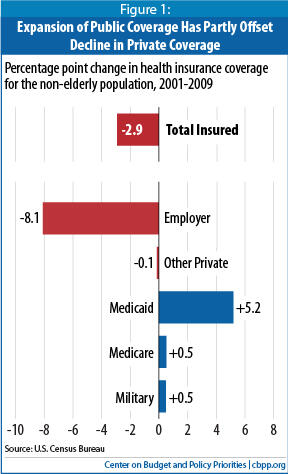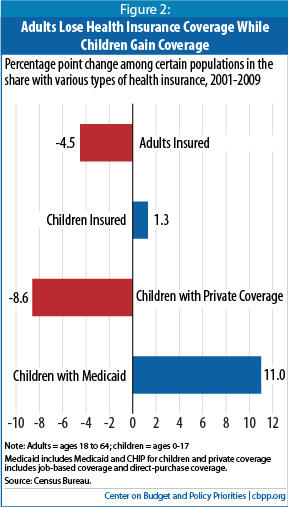- Home
- The Census Bureau’s Upcoming Report On H...
The Census Bureau’s Upcoming Report on Health Insurance
On September 13, the Census Bureau will release estimates of the number and percentage of Americans with, and without, health insurance coverage in 2010. Historical trends and other survey data suggest that:
- The number and share of Americans without health coverage are likely to have hit record highs in 2010. Nearly 51 million Americans, or one of every six, were without coverage in 2009 — the highest figures on record. Preliminary data suggest that these figures continued to grow in 2010 (albeit more slowly), due to persistently high unemployment and the rising cost of health insurance. (Note: the Census Bureau may revise these and other health insurance figures for 2009 when the new 2010 data are released; see the box below.)
- An increase in the uninsured population would largely reflect the continuing decline in employer-sponsored coverage. The share of the population with job-based insurance fell from 67.8 percent in 1999 to 58.9 percent in 2009, with the decline accelerating sharply in 2009 due to the recession. Costs for health insurance premiums increased between 130 and 140 percent in nominal terms over that period, making it more difficult for employers to offer health coverage and leading many employers that do offer it to pass along more of the costs to their employees, some of whom then drop or do not sign up for coverage. Preliminary data from other survey sources indicate that employer-sponsored insurance eroded further in 2010.
- The number of states experiencing significant increases since the start of the recession in the percentage of their population that is uninsured is likely to have grown further in 2010. The 2010 health insurance coverage data will reflect the cumulative impact of three years of acute pressure on job-sponsored coverage. From 2007 through 2009, the uninsured rate grew significantly in ten states. That number is expected to increase with the new data. The average annual unemployment rate was higher in 2010 than in 2009 in 32 states, and average single- and family-coverage premium costs grew faster than general inflation in 34 states.Image

- The uninsured rate will remain disproportionately high among Latinos, African Americans, young adults, people living in the South and West, and households with incomes under $25,000. Certain groups of Americans, typically those more likely to be employed in low-wage work or disconnected from the labor force, are more likely to be uninsured. For example, nearly one in three Latinos and one in five African Americans were uninsured in 2009, compared to one in ten non-Hispanic whites. Findings from previous years also show the uninsured rate to be particularly high among people aged 18 to 34, those living in the South or the West, and those living in households with less than $25,000 in income.
Census Bureau Refines Health Insurance Estimates
The Census Bureau indicates that, with the release of the 2010 data, it will be introducing an improved method of estimating insurance status in the Census Bureau's Current Population Survey (CPS).1 The share of the population with health insurance is expected to be higher than it would have been had Census not made this adjustment to the way it edits the survey data. Historical data for 1999 through 2009 also will be adjusted to reflect the revised method and thus to be comparable to the 2010 data.
This is not the first time the Census Bureau has refined its health insurance coverage estimates in the CPS.2 One earlier refinement resulted in a break in the historical data series, with years 1999 through the present reflecting one consistent survey method and years prior to that period (1987-1998) reflecting the prior approach. While the current method reflects a more accurate and lower estimate of the number of uninsured and the uninsured rate, this means that the health insurance data for the years 1999-2010 cannot be directly compared to health coverage data collected before 1999.
1 The Census Bureau imputes responses for some 11 percent of survey respondents who have not provided information on their health insurance coverage status. Non-respondents are matched to respondents with similar demographic profiles (age, employment status, poverty status, earnings) and are assigned the same health insurance coverage as those respondents. The Census Bureau will revise the imputation process to include family size among the demographic variables used for matching purposes and to assign coverage to all members of the household, where appropriate, as part of this imputation process.
2 Beginning in 1999, survey respondents who did not affirm coverage through any of the various health insurance sources (e.g., employer-sponsored insurance, Medicare, Medicaid, etc.) listed by the surveyor were asked a follow-up question to verify that they indeed were uninsured. In many instances, respondents then identified a source of health insurance coverage. The addition of the follow-up question resulted in the overall uninsurance rate declining by approximately 1 percentage point. In addition, in 2005, a coding error was discovered that resulted in many children formerly identified as uninsured instead being identified as having dependent coverage through a family member. This error was corrected for data back to 1999. - Public health insurance programs, particularly Medicaid and the Children's Health Insurance Program, are likely to have offset much or all of the loss of insurance among children that resulted from continued erosion of employer-based coverage. The past decade has exposed the serious weaknesses in the private health insurance market as it operates today: rising health care costs have made it more difficult for employers to offer affordable job-based coverage (particularly for small employers), and coverage rates have become worse due to the loss of millions of jobs during the recession.Image

But the past decade also has placed a spotlight on the large role of Medicaid and the Children's Health Insurance Program (CHIP) in effectively filling coverage gaps and limiting the growth of the uninsured. The uninsured rate among children has not increased but rather fallen, because Medicaid and CHIP have expanded coverage to children in families losing employer-based coverage. (Because public coverage is much less generous for parents than children, many of the parents in such families ended up uninsured.) The new Census data are likely to show that these programs stepped in again in 2010 to offset some or all of the loss of job-based health insurance coverage among children.
Under the Affordable Care Act, Medicaid will expand to cover low-income adults with incomes up to 133 percent of the poverty line (roughly $29,000 for a family of four in 2010) starting in 2014, and health insurance "exchanges" will be established in all states to make affordable private health insurance available to individuals and small businesses. The Congressional Budget Office estimates that by 2021, these changes will result in coverage for 34 million people who otherwise would be uninsured.
More from the Authors
